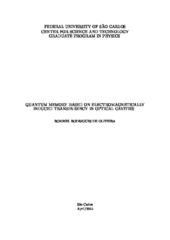| dc.contributor.author | Oliveira, Rommel Rodrigues de | |
| dc.date.accessioned | 2016-06-02T20:16:54Z | |
| dc.date.available | 2015-04-28 | |
| dc.date.available | 2016-06-02T20:16:54Z | |
| dc.date.issued | 2015-04-16 | |
| dc.identifier.citation | OLIVEIRA, Rommel Rodrigues de. Quantum memory based on electromagnetically induced transparency in optical cavities. 2015. 54 f. Dissertação (Mestrado em Ciências Exatas e da Terra) - Universidade Federal de São Carlos, São Carlos, 2015. | por |
| dc.identifier.uri | https://repositorio.ufscar.br/handle/ufscar/5074 | |
| dc.description.sponsorship | Universidade Federal de Sao Carlos | |
| dc.format | application/pdf | por |
| dc.language | eng | eng |
| dc.publisher | Universidade Federal de São Carlos | por |
| dc.rights | Acesso Aberto | por |
| dc.subject | Physics | eng |
| dc.subject | Óptica quântica | por |
| dc.subject | Informação quântica | por |
| dc.subject | Computação quântica | por |
| dc.title | Quantum memory based on electromagnetically induced transparency in optical cavities | eng |
| dc.type | Dissertação | por |
| dc.contributor.advisor1 | Villas-Bôas, Celso Jorge | |
| dc.contributor.advisor1Lattes | http://buscatextual.cnpq.br/buscatextual/visualizacv.do?id=K4705720J4 | por |
| dc.description.resumo | Recently a quantum memory for a coherent pulse was accomplished using an atom trapped inside a high finesse cavity, where an eficiency of 9:3% was achieved for a storage time of 2_s and an average fidelity of 93% for a storage time of 180fis. We theoretically studied this system using the master equation approach, exhausting all the possible ways one could improve the eficiency, defined here as the ratio between the mean number of photons retrieved after the memory process and the mean number of photons that enters the empty cavity, fi = hayaiout=hayaiin, which proved to have an upper bound of 25%. Since protocols relying on phase-matching conditions for single photon input states were already developed, using a model by H. Carmichael, a comparison between storage of coherent and single photon states was made, which did not gave rise any observable difference. Finally a more detailed study about the differences between an input-output and a master equation approach was done. It was concluded that the experimental setup suitable for observing cavity electromagnetically induced transparency (EIT) is not the ideal one for a quantum memory experiment. No modifications to the master equation theory were necessary, and a simple relation between the cavity and output fields was derived. | eng |
| dc.publisher.country | BR | por |
| dc.publisher.initials | UFSCar | por |
| dc.publisher.program | Programa de Pós-Graduação em Física - PPGF | por |
| dc.subject.cnpq | CIENCIAS EXATAS E DA TERRA::FISICA | por |
| dc.contributor.authorlattes | http://lattes.cnpq.br/1239076898021486 | por |
